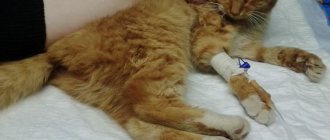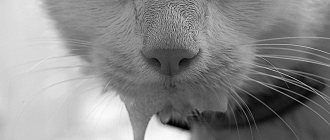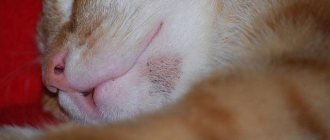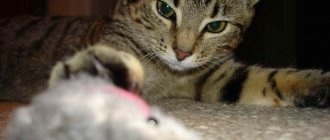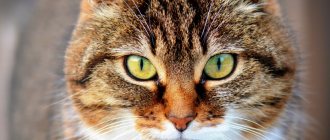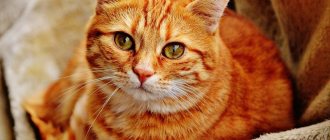Many pet cat owners are familiar with the problem of fleas appearing in their pet's fur. These blood-sucking insects not only cause serious discomfort to the animal, but can also carry dangerous diseases. The more fleas there are, the higher the risk of an allergic reaction, dermatitis or infection. Therefore, you need to learn how to detect these parasites in time and know how to get rid of them.
Fleas are common blood-sucking insects that live in animal fur. These parasites have a flattened body, thanks to which they easily move in the fur. Capable of jumping high - up to 30 cm. They bite through the skin and feed on the pet's blood, usually living on the stomach, near the ears - in those places where the skin is thinner.
How to tell if a cat has fleas
Each flea is small in size - 2-3 mm, and drinks little blood. The danger of infection by these insects is that they multiply quickly. A large number of parasites causes serious discomfort to the cat. They can cause the development of anemia, dermatitis, and allergic reactions. They carry worms and serious infectious diseases. Due to constant itching, the pet becomes irritable, and scratching the skin can cause infection.
Flea infection is especially dangerous for kittens and animals with weak immune systems. When there are a lot of insects, they can even bite a person. Therefore, you need to know what symptoms you can use to understand that your cat has fleas:
- the pet has become restless, irritable, and aggressive;
- his appetite decreased, he began to sleep poorly;
- often itches, licks itself intensively, rubs against the floor and walls;
- irritation or an allergic reaction appears on the skin;
- you can notice red spots, scratches, bleeding wounds;
- The condition of the fur has worsened: it has become dull and falls out.
How to check a cat
To understand that a cat's behavior change is caused by flea infestation and not by other insects or diseases, you need to examine it. Use your hands or a comb to part the fur, examining the skin. When infested with fleas, not only wounds and red spots on the fur will be noticeable, you can detect the insects themselves and traces of their vital activity. These are black dots, light small eggs.
You can place your pet on a white sheet or towel and comb the fur well with a fine comb and slicker brush. Black dots and the insects themselves will be immediately visible on white. To distinguish flea excrement from ordinary dirt, you need to slightly wet it. They will turn brown or red because they contain blood.
What symptoms can be used to determine the presence of blood-sucking parasites in cats?
If larvae appear in an animal's fur, they can only be identified through a thorough examination. There are no obvious symptoms at this stage. But along with the degeneration of the larvae into adults, special signs of fleas in cats will appear, which are worth paying close attention to.
- Restless cat behavior.
- Constant itching of the animal.
- The appearance of non-healing wounds and scabs on the skin.
- The appearance of tiny black specks (excrement in the fur).
- The appearance of red, swollen spots with a dot in the center (this is what flea bites look like).
In advanced cases, bald patches, fistulas, or even purulent abscesses may appear. The sooner the owner determines that the cat has fleas and begins treatment, the faster a positive result will be achieved.
How can a domestic cat become infected with fleas?
Some owners believe that if a pet does not go outside, then it cannot have fleas. But parasites often appear in domestic cats. These insects reproduce quickly, live at temperatures of 20-30 ° C, but during the cold season they settle in the basements of houses. The risk of infection is especially high if the cat lives in a rural area. But she can also become infected in the city. How do insects get on a cat's fur?
- from other pets, usually from dogs that walk outside;
- from mice, rats, even pigeons that fly to the balcony where the cat likes to sit;
- enter from the entrance when opening the door to the apartment, through ventilation or cracks from neighbors;
- brought on the shoes or clothes of people from the street.
How to treat bedding, carpets, furniture?
It is convenient to use sprays and aerosols to treat the room. Use a spray bottle to spray the cat's bed, corners of the room and all places where the cat could leave fleas. Bedding and clothes are thoroughly washed at the highest temperatures; if the fabric allows, they are boiled.
In a cat's house or box, you can put a sachet with aromatic herbs that repel insects: wormwood, geranium, lavender. If the cat was bathed in a decoction of wormwood or hellebore water, then you can wash the floors and walls with these liquids, and wash home rugs in them. Essential oils of geranium, eucalyptus, cedar, and lemon repel ectoparasites. You can spray the corners of rooms and furniture with them.
Review of flea products
There are many flea treatments sold in pet stores and veterinary pharmacies. They differ in method of application, cost, and the age and size of the pet must also be taken into account. To remove parasites the following are used:
- shampoos;
- sprays;
- drops on the withers;
- collars;
- pills.
Shampoos
The easiest and most popular way to rid a cat of parasites is to bathe him with a special shampoo. They contain essential oils and insecticides. Popular shampoos are Bars, Celandine, Lugovoy, BIO-GROOM, Doctor ZOO, Fitoelita. These products are suitable even for kittens and have many advantages:
- safe for pregnant cats and pets with allergies;
- have no contraindications, are easily tolerated;
- easy to use;
- are inexpensive.
But shampoos are effective only at the initial stage of infection, when there are still few insects. After bathing, the animal's fur acquires an aroma that insects do not like. It lasts 5-10 days. Therefore, you need to take measures to avoid re-infection: treat the apartment and the pet’s place.
Sprays
Sprays are the most effective remedy. Use only in case of severe infection after consultation with a veterinarian. They quickly destroy not only insects, but eggs and larvae. You can use Dana Ultra, Fiprist, Celandine, Frontline, BlochNet, Beaphar and others.
Sprays are toxic, suitable only for healthy adult cats, and can cause an allergic reaction. They should not be used frequently. When using, you must follow the instructions exactly:
- spray the spray from a distance of 25 cm;
- It is advisable to carry out the procedure outdoors or with an open window, wear protective gloves;
- wet all the animal’s fur, avoiding contact with the face and ears;
- For 15-30 minutes, make sure that the cat does not lick the fur or put a special collar on it;
- bathe your pet.
You can also find sprays for killing insects on furniture and objects on sale. They are less toxic, but cannot be used on animals. They are used to treat bedding, carpets, furniture, baseboards
Drops
Drops are the most popular way to get rid of parasites among pet cat owners. It is simple, effective and quite safe. They act quickly and protect against re-infection for 2-4 weeks. The drops are easy to apply; you don’t have to treat the apartment additionally. They are produced in disposable packaging in the form of a pipette. Popular means Bars, Frontline, Stronghold, Advantis, Advocate.
The drops contain insecticides and other substances that have a detrimental effect on insects, but are safe for the animal. In rare cases, they may cause an allergic reaction. Drops are applied to the skin in the withers area, from where they spread throughout the body. They accumulate in the sebaceous glands and are gradually released, repelling or destroying insects.
The drops should be used strictly according to the instructions, taking into account the age and weight of the pet:
- 3-5 days before the procedure, bathe the cat;
- spread the fur at the withers and drip the required amount of product onto the skin, preferably in several places, but not below the shoulder blades;
- Do not pet the cat for 24 hours and keep it away from children, as the substances released are toxic;
- Do not bathe your pet for 3-5 days, try not to let him get wet.
Collar
This is the easiest way to rid your cat of fleas. You just need to put a collar on him. It is impregnated with active substances, with a strong odor that parasites cannot tolerate. Popular collars are Bars, Celandine, Bio Band, Beaphar, Doctor ZOO, Bio Vax.
The effect of the collar lasts for several months. It protects against infection rather than kills insects, so it is more suitable for prevention. It is convenient to use if the cat often walks outside. It is better to use the collar after the fleas have been destroyed in another way. But you cannot use several products at the same time.
Sometimes active substances cause allergic reactions, in which case the collar must be removed and the pet bathed. This product should not be used if there are wounds or scratches on the cat’s neck. It is also necessary to take into account that the collar is worn for a long time, the fur under it cakes.
Tablets and injections
If external remedies are not suitable for the cat, for example, with dermatitis or serious skin damage, tablets are used. They contain insecticides that penetrate the animal's bloodstream. After being bitten, the insect dies. They can only be used as prescribed by a veterinarian. Comfortis or Lufenuron tablets are usually prescribed. They can be given to your pet along with food.
If the cat is in serious condition caused by parasites, an injection may be given at a veterinary clinic. This product is only suitable for healthy adult animals. The drugs Ivermectin, Eprimek and others are used.
Folk remedies
For mild infections, you can use folk remedies. They are also suitable for prevention. There are herbs with a strong odor and insecticidal properties. These are wormwood, tansy, chamomile, geranium. The plants need to be brewed and the wool moistened. Then it is advisable to wrap the cat in a towel and hold it for 15 minutes. It is better to unwrap it over the bathtub, as fleas will jump out. The same decoction can be used to treat the cat's area, carpets, and furniture.
Another effective non-native remedy is bathing with salt. A solution of 100 g per 1 liter of water is used, you need to immerse the cat in it up to the neck and hold for 10 minutes. Then wash with shampoo. After the procedure, comb out dead insects from the fur.
Precautions when treating cats with pharmaceutical drugs
We must not forget that drugs developed for cats can be harmful to dogs, guinea pigs and other pets. Likewise, cats should not be given flea medications labeled “for dogs.” After all, most tablets for dogs contain permethrin, which is very toxic to cats. You should also not use any chemical insecticides that have not been tested by a veterinarian. Even numerous folk remedies based on natural ingredients can be dangerous for your pet.
Before using any of the drugs, it is necessary to show the animal to a veterinarian. An incorrectly selected product can worsen the condition of your pet’s skin, or may not work at all.
The tablets can affect the condition of the cat's liver, so it is very important to calculate the dosage correctly. Sometimes weighing alone is not enough, so it is worth consulting with a veterinarian at least before the first use. You also need to be prepared for side effects. Comfortis and similar oral medications often cause vomiting. Other possible side effects:
- lethargic mood of the animal;
- decreased appetite;
- diarrhea;
- itching;
- shiver;
- increased salivation;
- convulsions.
No matter how severe the infection, you should not use all of the listed drugs at the same time. This is fraught with the development of very severe side effects, and even poisoning of the animal.
How to remove fleas from a cat
If you find fleas on your cat, you need to start fighting them as soon as possible. You can usually do this yourself. You should consult a veterinarian only in serious cases, in the presence of allergies, and also if a kitten under 3 months, a pregnant cat, or an elderly animal is infected.
The fight against parasites consists of several stages:
- Choose a drug depending on the pet’s age and weight, health condition and degree of infection. Be sure to carefully study the instructions and follow them.
- If there are only a few fleas, bathe the cat with a special shampoo. For severe infestation, use spray or drops. Be sure to follow the dosage recommended in the instructions.
- Disinfect the room, cat area, furniture.
- Repair damage caused by insects to your pet. Antihistamines and local antiseptics may be required for wound healing.
- Take preventative measures to avoid re-infection.
Features of treatment of kittens and pregnant cats
Kittens have weak immunity; they more often develop negative reactions to infection with parasites, anemia, and dermatitis. If you suspect the presence of fleas, it is advisable to contact a veterinarian who will help you choose the appropriate remedy. Shampoos are usually recommended. Combing the fur with a fine comb is also effective.
Pregnant and lactating cats should not use toxic products that can harm their offspring. They are also advised to use shampoo along with brushing their coat.
How to treat an apartment
The insects themselves, their eggs and larvae can be found on carpets, furniture, and under baseboards. There are a lot of them in the place of the cat, on toys. Therefore, after getting rid of parasites on the animal, it is necessary to treat the apartment.
It is necessary to do a wet cleaning, wash all textile interior items, and replace the bedding in the pet’s place. Furniture, carpets, mattresses need to be vacuumed and treated with steam.
In case of a serious infestation, when there are a lot of fleas, you will have to use insecticides. The most convenient are sprays that are sold in veterinary pharmacies and pet stores. During treatment, it is advisable to remove children and animals from the room for 2-3 hours, then ventilate it well.
Collars
They should only be used imported (Foresto, Kiltix, Scalibor). They do not have strong odors, are used for a long time (from 3 months or more), you can swim with them and not worry about a decrease in efficiency. The total cost of such a collar may be somewhat shocking (generally, the price of collars is over 1,500 rubles), however, when recalculating the amount for a month of use, it comes out even cheaper than the monthly use of good sprays or pipettes.
The main advantage is that, having put on the collar once, you forget about external treatments for a long time (you only need to pull the collar to the sides once every 2-3 weeks in order for the active substance to be released). But there are also disadvantages - the product is not suitable for hairless animals, continuous wearing is required for the entire period of action, it begins to work effectively on the 5-7th day of use (i.e. for this period it is worth limiting the animal from walking or using additional means of protection).
Prevention measures
To prevent a cat from becoming infected with fleas, preventive measures are needed:
- regularly carry out wet cleaning, thoroughly vacuum furniture and carpets;
- treat animal bedding and toys with disinfectants;
- limit the interaction of cats with street animals;
- periodically bathe the cat with a special shampoo;
- You can place herbs near the pet’s place: wormwood, sage, chamomile;
- use a collar or drops for preventive purposes in the summer, when the pet is taken to the countryside or into nature.
Fleas on cats are a common and unpleasant occurrence. But don’t panic, they are easy to get rid of with the help of special means. If you use them according to the instructions and follow the advice of the veterinarian, your pet will be healthy.
Drops
Anti-flea drops for cats and kittens are aqueous solutions of insecticides. They are very effective, but at the same time low-toxic for all warm-blooded animals. It is best to apply flea liquid to the withers, where the cat cannot reach it. In this case, poisoning is impossible.
Removal of parasites is provided by one of the following active substances:
- permethrin. A poison that does not cause poisoning if accidentally licked;
- pyriproxyfen;
- ivermectin. A universal remedy that is effective against many types of insects, in particular fleas, ticks and lice;
- fipronil – effective against lice and ticks, completely safe (does not cause poisoning).
Some drugs not only provoke poisoning, but also actively repel fleas with their smell. The treated pet becomes unattractive to jumping bloodsuckers.
Manufacturers offer a fairly wide selection of anti-flea drops.
| Beaphar | Effective cat drops for flea control, available in different formats - for sick pets, adult cats and kittens. Insect removal is provided by margosa extract, which is completely safe for pets and humans. The cat cannot get poisoned. The period of action of the drug is a month. It is best to repeat the treatment every four weeks. |
| Hartz | The product is based on methoprene, so it can be used in animals that are already 12 weeks old. At an earlier age, it is better not to treat the infection, since the risk of poisoning is high. The drug is applied in a targeted manner along the spine of the pussy. The death of insects - fleas, lice and ticks - occurs after a day. |
| Frontline | Good cat drops that protect against fleas, worms and ticks. Please note: half-millimeter pipettes are permitted for treating adult cats. Condition of use: the drug is approved for eight-week-old kittens. It has the ability to slightly change the color of the coat, so it is best not to use it on cats with white fur. |
| Advantage | Advantage is one of the most effective cat drops that can be used on pets. Flea control is achieved with imidacloprid. Applied to the withers, the drug "Advantage" provides protection for a month. Condition of use: animals should not lick each other for several hours after treatment. |
| Leopard | This is the development of a domestic manufacturer with insecticides that are safe but effective for pets. The drug "Bars" is an inexpensive remedy, but it works very well. |
Drops against fleas “Inspector”, “Dana”, “Advocate” and “Stronghold” have proven themselves to be quite good.
Shampoos
Special cat shampoos have a mild formula, especially if they are intended for bathing babies. During use, the manufacturer's instructions must be followed.
| Leopard | The shampoo cleanses the cat's fur, removing ticks, fleas and other ectoparasites. The composition is represented by essential oils and extracts from medicinal plants. Leopard does not dry out the skin and accelerates the healing of scratches caused by bites. |
| Phytoelite | Phytoelite is another good shampoo. The product works by enteric contact, i.e. causes paralysis and subsequent death of fleas. After applying the product to wet hair, wait five minutes and rinse. You can also wash the bedding in it to kill all the bloodsuckers. |
| Lugovoy | Good cat shampoo based on medicinal herbs. This is an excellent remedy against fleas, lice and lice. In addition, the product restores impaired metabolic processes in the bulbs and the cat’s fur becomes healthier and more beautiful. The shampoo foams well and is easily washed off, eliminating not only dirt, but also unpleasant odors. |
| BIO-GROOM | The shampoo contains pyrethrin and protein-lanolin. The first component ensures the removal of insects and also prevents their appearance. The second takes care of cats' fur: gently cleanses it of dirt, makes combing easier, removes specific odors and does not dry out the skin. |
| Celandine | Celandine is a good shampoo intended for adults and kittens. The drug destroys fleas and cares for the pet's fur. Celandine, intended for bathing kittens, does not irritate the eyes, therefore it is safe for cubs. |
| Rolf Club | A good cat shampoo that destroys all ectoparasites. The components included in its composition kill them, but do not harm the cat’s fur and skin. |
| BioVax | Anti-flea shampoo is a good insecticidal product that works against fleas, lice, lice and ticks. It is best to carry out treatment with BioVax in combination with other drugs of this brand - drops or sprays - to consolidate the results. Using other formats will help prevent re-infection. |
Sprays
The next effective home remedy is sprays. They kill bloodsuckers instantly, almost immediately after they hit the cat’s coat.
| Frontline | Frontline is packaged in a fairly large bottle - 100 ml. This volume is enough to protect a cat for 13...20 months. It all depends on the size of the pet and the degree of infestation. One treatment with Frontline spray will protect your cat for more than a month. If the animal has long hair, then you need to make sure that the drug gets on the skin. This is a mandatory condition, otherwise such treatment will not give results. |
| Hartz | The spray is produced in several formats: it can be used for both kittens and adult cats. The condition for using the product is that the baby reaches two months. In this case, an allergic reaction is completely excluded. |



